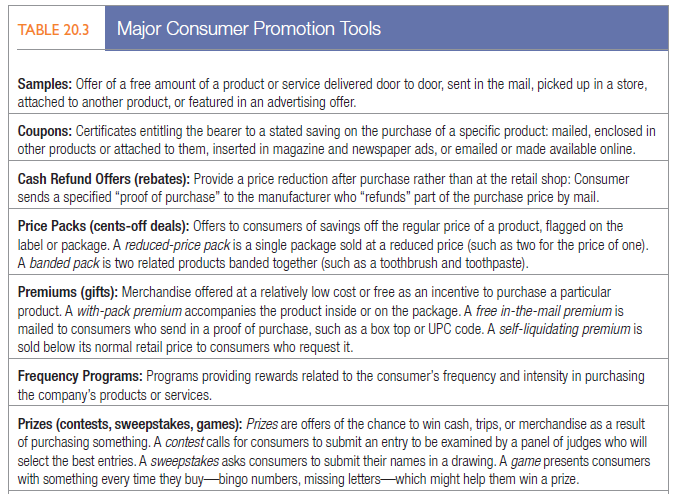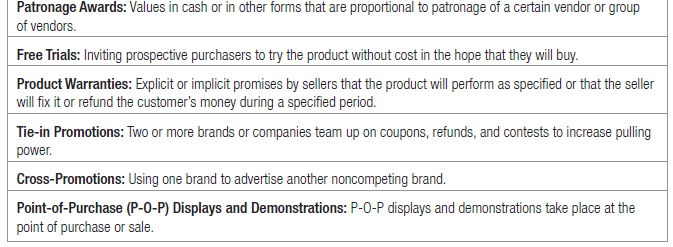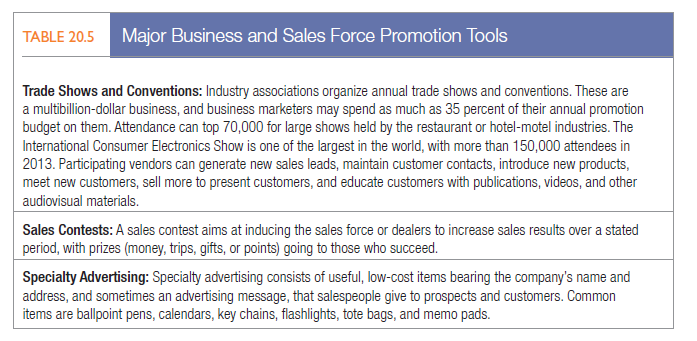Sales promotion, a key ingredient in marketing campaigns, consists of a collection of incentive tools, mostly short term, designed to stimulate quicker or greater purchase of particular products or services by consumers or the trade.47 Whereas advertising offers a reason to buy, sales promotion offers an incentive.
1. ADVERTISING VERSUS PROMOTION
Although sales promotion expenditures increased as a percentage of budget expenditure for a number of years, their growth has recently slowed. Consumers began to tune out promotions: Coupon redemption peaked in 1992 at 7.9 billion coupons but dropped to 2.9 billion by 20 1 3.48 Incessant price reductions, coupons, deals, and premiums can also devalue the product in buyers’ minds. Having turned to 0 percent financing, hefty cash rebates, and special lease programs during sluggish economic times, auto manufacturers have found it difficult to wean consumers from discounts ever since.49
Some sales promotion tools are consumer franchise building. They impart a selling message along with the deal, such as free samples, frequency awards, coupons with a selling message, and premiums related to the product. Sales promotion tools that are typically not brand building include price-off packs, consumer premiums not related to a product, contests and sweepstakes, consumer refund offers, and trade allowances.
Sales promotions in markets of high brand similarity can produce a high sales response in the short run but little permanent gain over the longer term. In markets with high brand dissimilarity, they may be able to alter market shares permanently. In addition to brand switching, consumers may engage in stockpiling— purchasing earlier than usual (purchase acceleration) or buying extra quantities. But sales may then hit a post-promotion dip.50
Price promotions also may not build permanent total-category volume. One study of more than 1,000 promotions concluded that only 16 percent paid off.51 Small-share competitors may benefit from sales promotion because they cannot match market leaders’ advertising budgets, nor can they obtain shelf space without offering trade allowances or stimulate consumer trial without offering incentives. Dominant brands offer deals less frequently because most deals subsidize only current users.
Consumer franchise-building promotions can offer the best of both worlds—building brand equity while moving product. McDonald’s, Dunkin’ Donuts, and Starbucks have given away millions of samples of their new products because consumers like them and they often lead to higher long-term sales for quality products.52 Gain’s “Love at First Sniff” campaign used direct mail and in-store scented tear-pads and ShelfVision TV to entice consumers to smell the product, resulting in an almost 500 percent increase in shipments over the goal.53
The fastest-growing area in sales promotions is digital coupons, redeemed via smart phone or downloaded to a consumer’s printer. Digital coupons eliminate printing costs, reduce paper waste, are easily updatable, and have higher redemption rates. Coupons.com gets 620,000 unique daily visitors looking for money-saving deals, and CoolSavings.com gets 120,000 seeking money-saving coupons and offers from name brands as well as helpful tips and articles, newsletters, free recipes, sweepstakes, free trials, free samples, and more. Many retailers are now offering customized coupons based on consumer purchase histories.54 One firm has devised a very different way for firms to offer discounts.55
GROUPON Groupon launched in 2008 to help businesses leverage the Internet and e-mail to use promotions as a form of advertisement. Specifically, the company sends its large base of subscribers a humorously worded daily deal—a specific percentage or dollar amount off the regular price—for a specific client’s branded product or service. Through these e-mailed discounts, Groupon offers client firms three benefits: increased consumer exposure to the brand, the ability to price discriminate, and the creation of a “buzz factor.” Groupon takes 40 percent to 50 percent of the revenues in each deal in the process. Many promotions are offered on behalf of local retailers such as spas, fitness centers, and restaurants, but Groupon also manages deals on behalf of some national brands. Some businesses have complained that Groupon attracts only deal-seekers and is not as effective in converting regular customers. One study found that 32 percent of companies lost money and 40 percent said they would not utilize such a promotion again, with restaurants faring the worst among service businesses and spas and salons being the most successful. Groupon has tried to innovate in several ways. Leveraging its massive sales force to sell Groupon Now, the company enlists local businesses to offer time- and location-specific deals via the Web or smart phones. The iPhone app for the new service has two buttons, “I’m Bored” and “I’m Hungry,” to trigger deals in real time. For businesses, the service is a way to boost traffic at otherwise slow times. Even a popular restaurant might still consider some midday and midweek discounts knowing it is rarely full then. After a heavily hyped IPO, its stock has not performed well as Groupon struggles to find the right business formula.
2. MAJOR DECISIONS
In using sales promotion, a company must establish its objectives, select the tools, develop the program, implement and control it, and evaluate the results.
ESTABLISHING OBJECTIVES Sales promotion objectives derive from communication objectives, which derive from basic marketing objectives for the product.
- For consumers, objectives include encouraging more frequent purchases or purchase of larger-sized units among users, building trial among nonusers, and attracting switchers away from competitors’ brands. If some of the brand switchers would not have otherwise tried the brand, promotion can yield long-term increases in market share.56 Ideally, consumer promotions have short-run sales impact and long-run brand equity effects.57
- For retailers, objectives include persuading retailers to carry new items and more inventory, encouraging off-season buying, encouraging stocking of related items, offsetting competitive promotions, building brand loyalty, and gaining entry into new retail outlets.
- For the sales force, objectives of promotion include encouraging their support of a new product or model, encouraging more prospecting, and stimulating off-season sales.
SELECTING CONSUMER PROMOTION TOOLS The promotion planner should take into account the type of market, sales promotion objectives, competitive conditions, and each tool’s cost-effectiveness. The main consumer promotion tools are summarized in Table 20.3. Manufacturer promotions in the auto industry, for instance, are rebates, gifts to motivate test-drives and purchases, and high-value trade-in credit. Retailer promotions include price cuts, feature advertising, retailer coupons, and retailer contests or premiums.58
SELECTING TRADE PROMOTION TOOLS Manufacturers use a number of trade promotion tools (see Table 20.4).59 They award money to the trade (1) to persuade the retailer or wholesaler to carry the brand; (2) to persuade the retailer or wholesaler to carry more units than the normal amount; (3) to induce retailers to promote the brand by featuring, display, and price reductions; and (4) to stimulate retailers and their sales clerks to push the product.
The growing power of large retailers has increased their ability to demand trade promotion.60 The manufacturer’s sales force and its brand managers are often at odds here. The sales force says local retailers will not keep the company’s products on the shelf unless they receive more trade promotion money, whereas brand managers want to spend their limited funds on consumer promotion and advertising.
Manufacturers often find it difficult to police retailers to make sure they are doing what they agreed to do and increasingly insist on proof of performance before paying any allowances. Manufacturers face several challenges in managing trade promotions.
- Some retailers are doing forward buying—that is, buying a greater quantity during the deal period than they can immediately sell. The manufacturer must then schedule more production than planned and bear the costs of extra work shifts and overtime.
- Some retailers are diverting, buying more than needed in a region where the manufacturer offers a deal and shipping the surplus to their stores in non-deal regions.
Manufacturers handle forward buying and diverting by limiting the amount they will sell at a discount or by producing and delivering less than the full order in an effort to smooth production.61
Ultimately, many manufacturers feel trade promotion has become a nightmare. It contains layers of deals, is complex to administer, and often leads to lost revenues.



SELECTING BUSINESS AND SALES FORCE PROMOTION TOOLS Companies spend billions of dollars on business and sales force promotion tools (see Table 20.5) to gather leads, impress and reward customers, and motivate the sales force.62 They typically develop budgets for tools that remain fairly constant from year to year. For many new businesses that want to make a splash to a targeted audience, especially in the B-to-B world, trade shows are an important tool, but the cost per contact is the highest of all communication options.
DEVELOPING THE PROGRAM In planning sales promotion programs, marketers are increasingly blending several media into a total campaign concept, such as the following award-winning promotion.63
SAMSUNG To promote its pricy ($450) Galaxy camera brand, Samsung developed a clever mobile and social campaign, “Life’s a Photo: Take It.” A two-month contest asked 32 of the most popular Instagram influencers from eight international markets to trade their favorite camera phone app for the Samsung Galaxy camera. Their task was to use the new camera to showcase their city on Instagram and Tumblr to prove it was the most photogenic. Each week a different feature of the camera was showcased and fans voted on their favorite photos. A video outlining the campaign was viewed 1.3 million times, brand awareness of the Galaxy camera improved 58 percent, and purchase intent increased 115 percent.
In deciding to use a particular incentive, marketers must first determine its size. A certain minimum discount is necessary if the promotion is to succeed. Second, the marketing manager must establish conditions for participation. Incentives might be offered to everyone or to select groups. Third, the marketer must decide on the duration of the promotion. Fourth, the marketer must choose a distribution vehicle. A 50-cents-off coupon can be distributed in the product package, in stores, by mail, online, or in advertising. Fifth, the marketing manager must establish the timing of promotion and, finally, the total sales promotion budget. The cost of a particular promotion consists of the administrative cost (printing, mailing, and promoting the deal) and the incentive cost (cost of premium or cents-off, including redemption costs), multiplied by the expected number of units sold. The cost of a coupon deal recognizes that only a fraction of consumers will redeem the coupons.
IMPLEMENTiNG AND EVALUATiNG THE PROGRAM Marketing managers’ implementation and control plans must cover lead time and sell-in time for each individual promotion. Lead time is the time necessary to prepare the program prior to launching it. Sell-in time begins with the promotional launch and ends when approximately 95 percent of the deal merchandise is in the hands of consumers.
Manufacturers can evaluate the program using sales data, consumer surveys, and experiments.
- Sales (scanner) data help analyze the types of people who took advantage of the promotion, what they bought before the promotion, and how they behaved later toward the brand and other brands. Sales promotions are most successful when they attract competitors’ customers who then switch.
- Consumer surveys can uncover how many consumers recall the promotion, what they thought of it, how many took advantage of it, and how it affected later brand-choice behavior.64
- Experiments vary such attributes as incentive value, duration, and distribution media. For example, coupons can be sent to half the households in a consumer panel. Scanner data can track whether they led more people to buy the product and when.
Additional costs include the risk that promotions might decrease long-run brand loyalty or be more expensive than they appear. Some are inevitably distributed to the wrong consumers. Special production runs, extra sales force effort, and handling requirements bring other costs. Finally, certain promotions irritate retailers, who may demand extra trade allowances or refuse to cooperate.
Source: Kotler Philip T., Keller Kevin Lane (2015), Marketing Management, Pearson; 15th Edition.

My brother recommended I might like this blog. He was entirely right. This post truly made my day. You cann’t imagine just how much time I had spent for this info! Thanks!